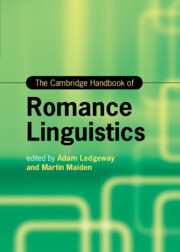Book contents
- The Cambridge Handbook of Romance Linguistics
- Cambridge Handbooks in Language and Linguistics
- The Cambridge Handbook of Romance Linguistics
- Copyright page
- Dedication
- Contents
- Figures
- Tables
- Contributors
- Abbreviations
- 1 Data, Theory, and Explanation: The View from Romance
- Part One What Is a Language?
- Part Two Phonetics and Phonology
- Part Three Morphology
- Part Four Syntax
- Part Five Semantics and Pragmatics
- 22 Word Meanings and Concepts
- 23 Key Topics in Semantics: Presupposition, Anaphora, (In)definite Nominal Phrases, Deixis, Tense and Aspect, Negation
- 24 Speech Acts, Discourse, and Clause Type
- 25 Address Systems and Social Markers
- 26 Information Structure
- Part Six Language, Society, and the Individual
- Index
- References
22 - Word Meanings and Concepts
from Part Five - Semantics and Pragmatics
Published online by Cambridge University Press: 23 June 2022
- The Cambridge Handbook of Romance Linguistics
- Cambridge Handbooks in Language and Linguistics
- The Cambridge Handbook of Romance Linguistics
- Copyright page
- Dedication
- Contents
- Figures
- Tables
- Contributors
- Abbreviations
- 1 Data, Theory, and Explanation: The View from Romance
- Part One What Is a Language?
- Part Two Phonetics and Phonology
- Part Three Morphology
- Part Four Syntax
- Part Five Semantics and Pragmatics
- 22 Word Meanings and Concepts
- 23 Key Topics in Semantics: Presupposition, Anaphora, (In)definite Nominal Phrases, Deixis, Tense and Aspect, Negation
- 24 Speech Acts, Discourse, and Clause Type
- 25 Address Systems and Social Markers
- 26 Information Structure
- Part Six Language, Society, and the Individual
- Index
- References
Summary
Traditionally, Romance diachronic lexicology has focused on the formal and content-level semantic history of nominal, verbal, adjectival, and lexical adverbial bases. Lately, specialists in general historical linguistics have explored the interface between what appears to be syntactic change and certain semantic phenomena affecting the lexical items involved in these shifts. They have examined facets of language change usually associated with syntax but with consequences for the semantic status of the items involved, such as recurrent paths of grammaticalization and the less common phenomenon of degrammaticalization, as well as lexicalization, subjectification, the genesis of pragmatic and discourse markers, and the creation of lexical items with evidential functions. Romanists working on issues of diachronic lexicology are beginning to focus their attention on the genesis and subsequent evolution of prepositions, grammatical particles, pragmatic and discourse markers, as well as the acquisition by some independent lexical items of evidential and subjectification functions. Consequently, they are forging a new link between diachronic syntax and lexicology. Such an approach to lexical studies constitutes a fruitful meeting place for Romanists and for specialists in general historical linguists.
Keywords
- Type
- Chapter
- Information
- The Cambridge Handbook of Romance Linguistics , pp. 673 - 694Publisher: Cambridge University PressPrint publication year: 2022



